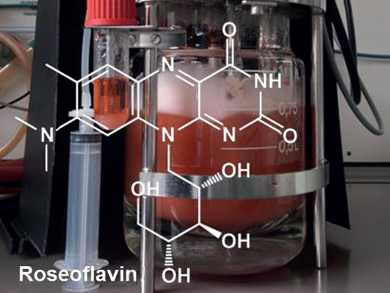The antibiotic roseoflavin is a vitamin B2 (riboflavin) analogue and is produced by the bacteria Streptomyces davawensis and Streptomyces cinnabarinus. Disguising an antibiotic as a vitamin is a good strategy since many cells readily take up vitamins from the environment (“Trojan horse principle”) and since toxic vitamin analogues have multiple cellular targets.
Matthias Mack, Mannheim University of Applied Sciences, Germany, and colleagues have discovered that several key steps in the biosynthesis of the antibiotic roseoflavin are catalyzed by a single enzyme. Mack’s group is interested in the biosynthesis and the mode of action of vitamin analogues. These compounds could help to replenish the arsenal of antimicrobials urgently needed to fight bacterial pathogens.
It turned out to be surprisingly easy to convert a vitamin to an antibiotic. Initially, Mack and his team thought that a series of enzymes is necessary to produce roseoflavin from riboflavin in S. davawensis and S. cinnabarinus. However, using systematic gene deletion, they were able to show that a single enzyme (the 8-demethyl-8-aminoriboflavin-5′-phosphate synthase, RosB) is able to carry out the key reaction, which requires the substitution of a methyl group by an amino group on an aromatic ring.
RosB is the first known member of a novel class of enzymes and may be very useful to carry out chemical reactions which previously would not have been possible.
- Identification of the Key Enzyme of Roseoflavin Biosynthesis,
Julia Schwarz, Valentino Konjik, Frank Jankowitsch, Roger Sandhoff, Matthias Mack,
Angew. Chem. Int. Ed. 2016.
DOI: 10.1002/anie.201600581




